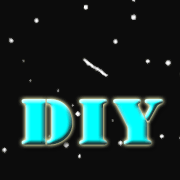
Near Earth Asteroids
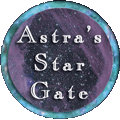


How to Make Observations of Near Earth Asteroids
Observing asteroids is different from the other solar system objects you may have observed. These solar system objects are faint and are often moving quickly, so that the window for making observations may be quite short. This page contains hints and tips on observing Near Earth Asteroids.
Links open a new window. Don't close the new window, return to this page and load the next link, it will open in the same new window. It's easy to follow links from the NEA pages without creating multiple pages. All links on the NEA pages at Astra's Stargate that leave the site work this way.
Happy Hunting!
- - Astra
Find out about the December 12th Occultation of Alpha Orionis, aka Betelgeuse on this page!

Hunting Asteroids From Your Backyard - an article with observing tips from Sky and Telescope by Dennis di Cicco.
Amateur Astronomers observe 2012 da14 - Turn your speakers down or up for the music that plays with this over view of an astronomical expedition to observe the crossing of 2012 DA14 in February 2013 from from J.D.Strikis
Asteroid Data Hunter - Armchair astronomers, discover new asteroids @home! NASA provides an app to identify asteroids in images.
The tenth brightest star in the sky, Betelgeuse (Alpha Orionis) is a first-magnitude star in the constellation of Orion, about 650 light years away, although there is some uncertainty about its actual distance. It is a variable red giant star that is about 700 times larger than our own Sun. Betelgeuse is one of the best observed stars and it has caused quite a stir over the last few years due to notable dimming and brightening. As an old star, some have wondered if they will see it go nova in their lifetimes. This will only happen if the event has already taken place because light from Betelgeuse takes 650 years to travel to Earth.
319 Leona is a 14th magnitude main-belt asteroid orbiting the Sun about every 6.3 years. It was discovered in 1891, by the astronomer Auguste Charlois at the Nice Observatory. There is some uncertainty about the size and shape of the asteroid, but it is large ~70km in diameter. On December 12, Leona will interrupt the light heading toward Earth from Betelgeuse before it arrives at Earth, no matter how long ago it left the star. Recent occultations by Leona of distant stars have been improving our knowledge of the asteroid's dimensions. Leona presents no danger to the Earth as it orbits well beyond Mars, 2.7 AU away from the Sun.
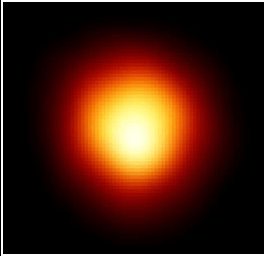
To make scientifically meaningful observations of this event, an instrument with an aperture of 60 to 100 mm and a clock drive can be used. (More detailed images can be obtained with larger instruments.) As with a solar eclipse, the event has a centerline with areas to the north and south that will have partial coverage of Betelgeuse by the asteroid. In fact, it is not certain that Betelgeuse will even be totally covered because of uncertainties that remain regarding the actual sizes of the asteroid Leona and of Alpha Orionis. The International Occultation Timing Association (IOTA) collects data and coordinates observers for making these types of observations.
To be clear, for observers in Florida, U.S.A., 1:17 UT on December 12 will translate to 8:17 pm Eastern Standard Time (EST) on December 11, 2023. Observers in Mexico will have to adjust their occultation time accordingly. Observers in Europe, will be able to view the occultation a few seconds earlier as the occultation path crosses the Earth. The time of the occultation varies from 6 to 12 seconds, depending on where an observer is on the track of the occultation. Observers not on the centerline of the track will see only a partial occultation. Observations along the entire track are needed. A greater number of observations make the data more valuable.
Join the The Virtual Telescope Project 2.0 on December 12, 2023 at 01:00 UTC to view the occultation live from southern Italy!

The occultation of Betelgeuse by 319 Leona is very much like a solar eclipse. There is a narrow path of visibility with a centerline. Of course, observers on the centerline see the deepest eclipse. The occultation will only be seen in a narrow band across the planet. Observations from various astronomers or stations are combined together to make a more complete picture. Usually, asteroid occultation opportunities give Earth based astronomers a chance to find out more about the asteroid, but in this case we have an excellent opportunity to learn more about one of the most enigmatic stars we know. Betelgeuse rotates very slowly. It is believed to rotate once every 36 years! The convection cells inside the star may remain stationary for months, even years.
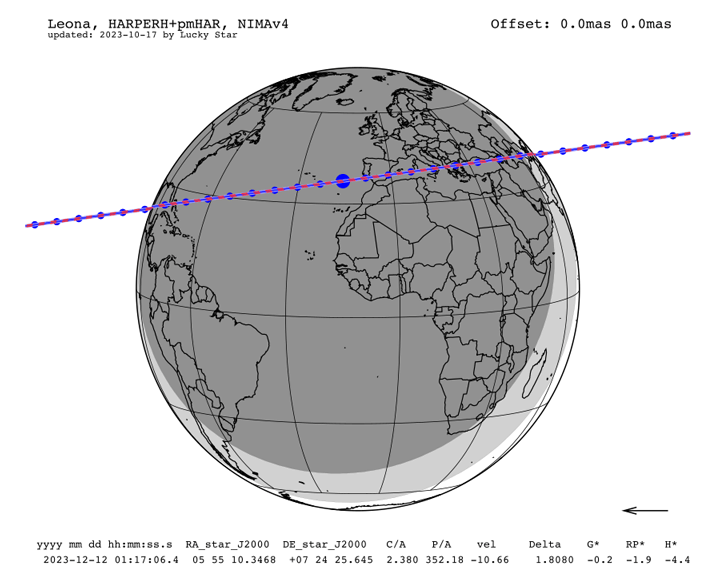
Observers in southern Florida and elsewhere will enjoy a sky that is moon free, but the constellation of Orion will be low on the horizon. Photometric observations are the best, but this event may be of interest to star gazers on the path of the eclipse. (Yes, occultations are eclipses!) Betelgeuse shines at magnitude 0.5. Betelgeuse is expected to drop 3 magnitudes, effectively glowing as a 3.5 mag star during deepest eclipse.
IOTA is looking for observations using filters R and V to detect Titanium(II) oxide (TiO bands); R and B filters for the chromosphere of Betelgeuse; and R and H-alpha for the extended atmosphere.
There is a North America Asteroidal Occultation Program website that is apparently part of IOTA. Use this link if you need an IOTA report form.
Future Asteroid Events - maintained by Derek C. Breit
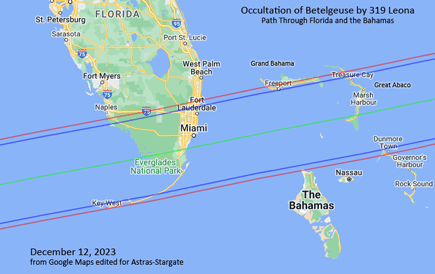

Journal for Occultation Astronomy - Vol. 13, No. 4 Rev. 1
Published by the International Occultation Timing Association (IOTA) the journal contains detailed information on the upcoming occultation. IOTA is a scientific organization that promotes the observation, prediction, and analysis of lunar and asteroid occultations and solar eclipses. IOTA has organized observers worldwide to make occultation observations of the stars by the Moon, eclipses of stars by asteroids and solar eclipses since 1962.
Occultation of Betelgeuse by (319) Leona on 2023 December 12 - charts for the IOTA Zoom meeting on July 15, 2023
Presented by David W. Dunham, Dave Herald, and Ted Blank. These presentation charts cover the occultation of Betelgeuse by 319 Leona and other Leona occultation events that helped observers to prepare for the occultation on December 12, 2023. A YouTube video of the presentation is available: 319 Leona occults Betelgeuse on Dec. 12th David Dunham
Download IOTA's observing manual: The Complete Guide to Observing Lunar, Grazing and Asteroid Occultations
Photometry and spectroscopy of Betelgeuse (α Ori) during its occultation by 319 Leona of 12/12/2023
Betelgeuse Occultation by Leona Simulator - StarBlink.org
Asteroid Will Cover Betelgeuse, May Reveal Its Visible Surface
This Sky and Telescope article, written by Jan Hattenbach, is a nice article on the subject.
The 2023 December 11/12 occultation of Betelgeuse by (319) Leona
This write up was created by the Royal Astronomical Society of Canada and it contains information updated on November 28, 2023 regarding the Event
What is Betelgeuse? Inside the Strange, Volatile Star - May 3, 2023
NASA Science Universe Exploration explains the erratic behavior of Alpha Orionis
Watch an Asteroid Block Betelgeuse: The Occultation of Betelgeuse by 319 Leona - from NASA Science News

Observe Asteroids
+ Minor Planet Electronic Circulars
Find new discoveries or NEAs that require updated observations.
British Astronomical Association (BAA)
Asteroid and Remote Planets Section - BAA members share their knowledge and asteroid observing expertise. Information available includes definition, observing techniques and personal experiences to aid amateur asteroid observers. An example of the type of work that can be found here: A method for determining the V magnitude of asteroids from CCD images - Roger Dymock & Richard Miles
Robert K. Buchheim discusses amateur observations of asteroid phase curves and other topics. Research papers on observing asteroids include H-G parameters of asteroid phase curves, photometric study of 371 Bohemia, and lightcurves of 755 Quintilla and 147 Protogenia.
Collaborative Asteroid Lightcurve Link (CALL)
Amateurs involved in asteroid photometry and lightcurve work coordinate their efforts and support the asteroid observing community. Find help here to make best use of your observing time through the MinorPlanet.Info gateway. Links to observing guides, the light curve database, and more
Minor Planet Observer and Palmer Divide Observatory
Brian D. Warner, owner/director of the Palmer Divide Observatory recipient of the Shoemaker award - link on the observation page is broken, fill out more information and put in a name anchor to click on it.
International Occultation Timing Association (IOTA)
IOTA sponsors the North American Asteroidal Occultation Program - IOTA members observe occultations of asteroids and other solar system objects. Observers share their knowledge and asteroid observing expertise. Asteroid in the solar system occult distant stars. The star is usually several magnitudes brighter than the asteroid and may be too faint to be detected in a small telescope. Observers find the star to be occulted and monitor it for any drop in brightness that means the asteroid is in front of the star. This last for only a few seconds and there may be multiple events. Observations are collected and published regularly.
Wait! There's more . .
Observing Asteroids, NEOs and Comets from Las Cumbres Observatory Global Telescope Network
This page was updated by Dawn Jenkins, December 8, 2023.